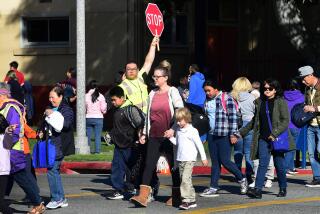Rage Isn’t Just a No-Signal Turn
- Share via
It’s good that the phenomenon of “road rage” has earned the scrutiny of federal transportation officials. But it’s not reassuring that the same officials have muddied the issue by including in the “rage” category incidents that are mere lousy driving. Plain bad driving has little to do with the increasing displays of unwarranted and uncontrollable anger that have caused so much recent concern.
The term “road rage” and its catchy variations, such as Mad Max syndrome, refer mainly to threatening and sometimes violent behavior intentionally inflicted on one or more other motorists. The most alarming have involved fatal assaults. Such incidents are often precipitated by the smallest of perceived slights.
And the problem is international in scope. A recent British study, for example, found that 18% of motorists surveyed had been threatened by another driver. In fact, Great Britain has already launched road rage awareness campaigns and is seeking requirements that offenders receive counseling and stiffer penalties.
But here in the United States the National Highway Transportation Safety Administration has instead decided to press a broad agenda against “aggressive driving.” That includes speeding, tailgating, risky lane changes, running stoplights and stop signs and more. In other words, just about every form of bad driving that could result in physical injury.
It’s fine if the safety agency wants to launch an attack on bad motoring practices, but it dilutes any effort against those drivers who fly into a rage and run you off the road, ram your car or truck, follow you home or even assault you outside your vehicle. Those perpetrators are usually young males with poor educations and histories of criminality and violence. That’s a far cry from the merely unskilled or thoughtless fellow you’ll encounter on the road this morning who seems to have obtained his driver training through a home study course.
More to Read
Sign up for Essential California
The most important California stories and recommendations in your inbox every morning.
You may occasionally receive promotional content from the Los Angeles Times.













